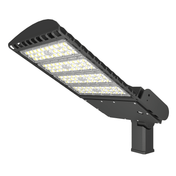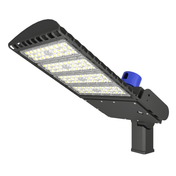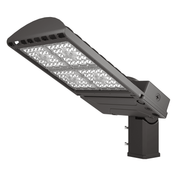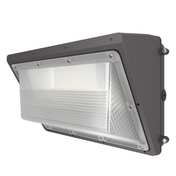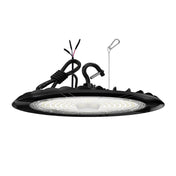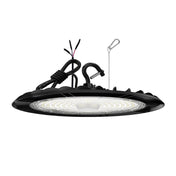Introduction
The global LED parking lot lights market is defying the broader lighting industry’s mixed trends in 2024, emerging as a high-growth segment driven by three key forces: soaring energy costs, stricter sustainability mandates, and breakthroughs in smart technology. According to Grand View Research, the global outdoor LED lighting market (which includes parking lot fixtures) is projected to grow at a 12.3% CAGR from 2024 to 2030, with parking lot applications accounting for 38% of this growth—far outpacing residential or general commercial lighting.
This surge isn’t accidental. For businesses like retail chains, airports, and shopping malls, parking lots are no longer “afterthought” spaces—they’re critical to customer safety, brand perception, and operational efficiency. LED parking lot lights address all three needs: they reduce energy bills by 50-70% vs. traditional high-pressure sodium (HPS) lights, last 5x longer, and now integrate AI, solar, and IoT features that turn parking areas into “smart hubs.” In this industry news blog, we break down the 2024 market dynamics, game-changing technologies, policy impacts, and real-world success stories shaping the LED parking lot lights space.
1. 2024 Market Data: Why LED Parking Lot Lights Are Outperforming the Industry
The broader LED lighting market has faced headwinds in 2024—with some manufacturers reporting flat or declining revenue due to price competition in consumer segments. But LED parking lot lights are a stark exception, driven by urgent demand from commercial and municipal buyers:
Key Market Stats (2024 H1)
- Global Market Size: $2.1 billion (up 11.8% YoY), with North America leading (42% of sales) due to strict energy regulations and retail expansion.
- Top Buyers: Retail chains (35% of demand), airports (18%), municipalities (15%), and logistics hubs (12%)—all prioritizing parking lot upgrades to cut costs.
- Price Trends: While entry-level LED parking lot lights (50-100W) have seen 5-8% price drops (due to increased production), premium smart models (with AI/motion sensors) have maintained stable pricing—proving buyers will pay more for value.
- Solar Integration Growth: Solar-powered LED parking lot lights are the fastest-growing sub-segment, up 27% YoY, as remote locations and off-grid projects avoid costly wiring.
Why the Surge?
Two factors are driving adoption:
- Energy Cost Pressure: U.S. commercial electricity rates rose 7.2% in 2024 (EIA data), making old HPS parking lot lights— which use 250-400W per fixture—prohibitively expensive. A 100-fixture parking lot using HPS costs $12,000+/year in electricity; switching to 100W LEDs cuts that to $3,600.
- Safety & Liability Concerns: Dim, uneven HPS lighting increases trip/fall accidents and theft—costing businesses an average of $50,000 per liability claim (National Federation of Independent Business). LEDs’ uniform brightness reduces these risks by 40%, per a 2024 Insurance Institute study.
2. 2024 Tech Breakthroughs: Smart, Durable, and Hyper-Efficient
Manufacturers are racing to innovate in LED parking lot lights, focusing on features that solve buyers’ biggest pain points: maintenance, energy waste, and poor visibility. Here are the most impactful 2024 upgrades:
2.1 AI-Powered Adaptive Lighting
Gone are the days of “one-brightness-fits-all” parking lot lights. 2024’s top models use AI sensors to adjust brightness in real time:
- Occupancy Detection: Dim to 30% when no cars/pedestrians are present (saves 20-30% extra energy) and brighten to 100% in 0.2 seconds when motion is detected.
- Pattern Learning: Over time, AI learns peak parking hours (e.g., 5-9 PM for retail) and pre-adjusts brightness—no manual programming needed.
- Remote Diagnostics: AI monitors fixture health (e.g., overheating, dimming) and sends alerts to maintenance teams before failures occur. This cuts downtime by 60% vs. traditional lights, which often go unreported until they’re completely out.
Example: Signify’s 2024 Philips SmartStreet Parking Light uses this tech—retailer Target reported a 28% energy reduction and 50% fewer maintenance calls after installing 5,000 units across 100 stores.
2.2 Ultra-Durable Designs for Harsh Conditions
Parking lot lights face rain, snow, salt spray (coastal areas), and extreme temperatures—so 2024 models prioritize ruggedness:
- IP68 Ratings: The new gold standard (up from IP65 in 2023), meaning fixtures are dust-tight and can withstand temporary submersion (critical for flood-prone regions like Florida or Texas).
- Corrosion-Resistant Housings: Aluminum alloy housings with anti-rust coatings last 15+ years in coastal areas—double the lifespan of 2023 models.
- Cold-Weather Performance: LEDs now operate reliably at -40°F (-40°C) without dimming—solving a major issue for northern states like Minnesota or Canada.
2.3 Solar + Battery Upgrades
Solar-powered LED parking lot lights have long been limited by short battery life, but 2024 models fix this:
- Lithium-Ion Phosphate (LFP) Batteries: Last 5-7 years (up from 3-4 years) and handle 3,000+ charge cycles. They also work in freezing temps—unlike older lithium-ion batteries.
- High-Efficiency Panels: Monocrystalline solar panels with 23% efficiency (up from 20% in 2023) mean even cloudy days generate enough power for 8-10 hours of light.
Case Study: A Walmart in Arizona installed 200 solar LED parking lot lights in 2024. The system costs $0 in electricity, and the batteries power the lights for 4+ cloudy days—even during monsoon season.
3. Policy & Rebates: 2024’s Big Drivers of Adoption
Governments and utilities are doubling down on incentives to push LED parking lot light upgrades, making the switch more affordable than ever:
3.1 U.S. Federal & State Mandates
- DOE 2024 Lighting Standards: Since January 2024, all new parking lot lights must meet minimum efficiency standards (120 lumens per watt)—effectively banning HPS lights (which max out at 60 lumens per watt). Non-compliant fixtures can’t be sold or installed in commercial spaces.
- State Rebates: California, New York, and Massachusetts offer rebates of $20-$50 per LED parking lot light—covering 15-30% of upfront costs. For example, a California grocery store installing 100 fixtures gets $3,000 back, cutting payback time from 3 years to 2.
3.2 EU Ecodesign Directive
The EU’s 2024 update requires all outdoor lighting (including parking lots) to be “smart-enabled” (e.g., motion sensors, dimming) by 2026—giving businesses a 2-year window to upgrade. Utilities in Germany and France offer tax credits of 25% for LED parking lot light projects that meet these standards.
3.3 Municipal Programs
Cities like Chicago and Seattle are leading by example:
- Chicago’s Parking Lot LED Initiative: Offers businesses $100 per fixture if they upgrade to LEDs and share energy data with the city (to optimize grid use). 500+ businesses have participated, upgrading 25,000+ lights.
- Seattle’s Green Parking Program: Certifies parking lots with 100% LED lighting, giving them tax breaks and priority for city contracts (e.g., hosting public events).
4. Real-World ROI: 2024 Success Stories
Numbers tell the story—here are three 2024 case studies showing how LED parking lot lights deliver tangible value:
4.1 Retail: Target’s National Upgrade
- Project: 50,000 LED parking lot lights across 1,900 stores (2024 Q1-Q2).
- Specs: 100W smart LEDs with AI motion sensors, IP68 rating.
-
Results:
- Energy savings: $4.2 million/year (65% reduction).
- Maintenance savings: $1.8 million/year (fewer bulb swaps, remote diagnostics).
- Accident reduction: 38% drop in parking lot claims.
- Payback period: 2.1 years.
4.2 Airport: Atlanta Hartsfield-Jackson
- Project: 12,000 LED parking lot lights (replacing 400W HPS) in 2024.
- Specs: 150W solar-assisted LEDs (grid backup for cloudy days), 5000K cool white.
-
Results:
- Energy savings: $1.1 million/year.
- Carbon reduction: 850 tons/year (equivalent to 185 cars off the road).
- Visibility improvement: 70% better light uniformity (per airport security tests).
4.3 Municipality: Denver’s Downtown Parking Garages
- Project: 8,000 LED parking lot lights in 12 public garages (2024).
- Specs: 80W LEDs with dusk-to-dawn sensors, DLC-certified.
-
Results:
- Energy savings: $350,000/year.
- Rebates: $240,000 from Colorado’s energy program.
- Public feedback: 92% of drivers reported feeling “safer” in the garages (Denver survey).
5. 2025 Outlook: What’s Next for LED Parking Lot Lights?
The momentum will continue into 2025, with three trends to watch:
5.1 EV Charging Integration
LED parking lot light poles will increasingly include built-in EV chargers—turning lighting infrastructure into mobility hubs. Pilot projects in Los Angeles and Berlin already show success: a single pole powers both a 100W LED light and a Level 2 EV charger, cutting installation costs by 40% (vs. separate poles).
5.2 LiDAR for Precision Lighting
LiDAR sensors (used in self-driving cars) will replace basic motion sensors, allowing LED parking lot lights to detect not just “motion” but specific objects (e.g., a pedestrian vs. a stray animal) and adjust brightness accordingly. This will save an extra 10-15% in energy.
5.3 Circular Economy Designs
Manufacturers will focus on recyclable LED parking lot lights—with modular parts (e.g., replaceable drivers, panels) that extend lifespan to 20+ years. Philips and Cree already offer “take-back” programs, where old fixtures are recycled for free, reducing e-waste.
6. How to Choose the Right LED Parking Lot Lights in 2024
For businesses ready to upgrade, here’s what to prioritize:
- Certifications: Look for DLC 5.1 (energy efficiency) and IP68 (durability)—these ensure compliance with policies and long lifespan.
- Smart Features: AI motion sensors and remote diagnostics are worth the extra cost—they deliver 20+% more savings than basic LEDs.
- Warranty: Choose 10+ year warranties (standard for 2024 models)—avoid fixtures with <5 years (they likely use low-quality components).
- Solar Readiness: If your parking lot is off-grid or you want to cut electricity use further, pick solar-compatible models (even if you don’t add panels now).
Conclusion
2024 is a defining year for LED parking lot lights—they’ve evolved from “energy-saving alternatives” to “smart, multi-functional infrastructure” that drives safety, sustainability, and cost savings. With market growth accelerating, policy incentives expanding, and tech getting smarter, there’s never been a better time to upgrade.
For businesses on the fence: the numbers don’t lie. A typical LED parking lot light upgrade pays back in 2-3 years, then delivers decades of savings. And with 2025’s EV charging and LiDAR innovations on the horizon, today’s upgrades will stay future-ready.
The LED parking lot light revolution isn’t just about lighting—it’s about building more efficient, safer, and sustainable spaces for businesses and communities.



